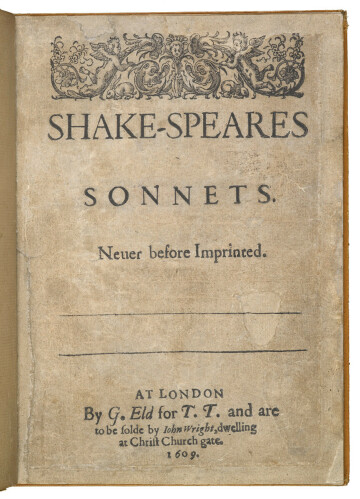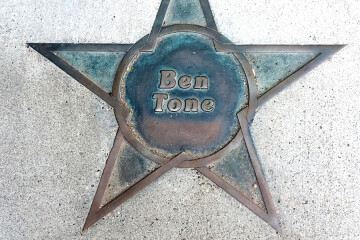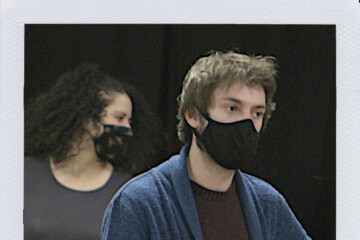Sonnets in the Snow

The desire to create is something important to humanity—a fundamental part of our very existence. The Covid19 pandemic has limited the outlets for this creative urge in everyone around the world, leaving not only frustrated audiences, but even more frustrated actors unable to create art, perform plays, and explore ideas through live theatre in front of live audiences.
One local theatre company in town is taking a new approach to resolving the unrequited need to create and perform, an attitude familiar to those who love living here: “embrace the season.” But how do you embrace the season with live theatrical performances when you can’t perform indoors and it’s winter in Montana? By taking the art outside and using the medium so many embrace when it’s wintertime and snowy: snowshoes and skis. And that’s what Montana InSite Theatre (MIST) is doing with its production of “Sonnets in the Snow.”
On Saturday and Sunday, February 6 and 7, Montana InSite Theatre presents “Sonnets in the Snow,” with eight actors on skis doing the Blackmore Loop ski trails between History Rock trailhead and Hyalite Reservoir, reciting sonnets to anyone on the trails who would like to hear these poems.
On both afternoons between 1 and 4 pm, the audience can ski, snowshoe, or walk the History Rock loop trails. There are no guides or pods of people—audience members can come and go at whatever time is convenient for them during these three-hour entirely self-guided sonnet performances. Actors will be skiing or snowshoeing these trail loops between Hyalite Reservoir and History Rock trailhead, wearing something (a shirt or vest perhaps) that clearly designates them as a sonnet performer, and audience members can ask them to stop and recite a sonnet at any time their paths cross.
The emphasis of “Sonnets in the Snow” will be, as the name implies, sonnets. Sonnets originated in Italy in the 13th century. Often poet Giacomo da Lentini is credited with the sonnet’s invention and the Sicilian School of poets who surrounded him is credited with its spread and original popularity. Like the musical sonata, sonnets have a very specific form they follow, creating a “box” for telling stories and examining situations.
Sonnets are a style of poetry that uses a specific form in a poem, usually composed of fourteen lines using any of a number of formal rhyming schemes. Shakespearean sonnets— commonly known as English sonnets— are the most recognized style to many of us. These sonnets are written in iambic pentameter with ten syllables per line that fall into a pattern of unstressed, stressed rhythm.
An example of a famous sonnet that most people are at least slightly familiar with is Elizabeth Barrett Browning’s “Sonnet 43”:
How do I love thee? Let me count the ways.
I love thee to the depth and breadth and height
My soul can reach, when feeling out of sight
For the ends of being and ideal grace.
I love thee to the level of every day’s
Most quiet need, by sun and candle-light.
I love thee freely, as men strive for right.
I love thee purely, as they turn from praise.
I love thee with the passion put to use
In my old griefs, and with my childhood’s faith.
I love thee with a love I seemed to lose
With my lost saints. I love thee with the breath,
Smiles, tears, of all my life; and, if God choose,
I shall but love thee better after death.
MIST’s production of “Sonnets in the Snow” includes a varied list of poets and sonnets, ranging from Browning to Shakespeare talking about love to modern-day poets such as Seamus Heaney writing about civil rights in Ireland during the times of The Troubles (Heaney received the Nobel Prize for Literature in 1995). Poet Laureate of the United States in the 1960s Robert Frost wrote sonnets about nature which will be represented. What these varied voices represent references one of the very definitions of sonnets: they are a specific style of poetry that provides a framework within which poets tell stories and investigate emotions, events, and situations.
MIST encourages everyone to come and enjoy the marriage of art in the form of poetry combined with exercise while embracing the seasons as only we here in Montana can do. There will be check-in stations for audience members at the History Rock and Blackmore parking areas up Hyalite Canyon just shy of the reservoir. At these check-in stations, audience members can receive maps of the area and ask questions. This is a free event, but please email MIST at montanainsitetheatre@gmail.com to get your complimentary tickets. Donations for the performers will be accepted at the check-in stations and split evenly between all the performers. Audience members can come and go at any time between 1 and 4 pm, do the whole five-mile route or any portion of it. The sonneteer performers will be circulating along all the loops of these trails.
The mood of this event will be somewhat like a scavenger hunt, and hopefully people will get excited about finding as many of the performers as possible. MIST may offer prizes for those who hear the most sonnets.
These trails can be snowshoed or walked as well as skied, so if any performers or audience members prefer a different mode of transport, that’s fine.
Sonnets are often associated with Valentine’s Day, and thus I leave you with one of the greatest sonnets ever written, for you to memorize and recite to someone you love in honor of St Valentine, “Sonnet 18” (by William Shakespeare). Notice how Shakespeare’s sonnet ends with a two-line rhyming couplet:
Shall I compare thee to a summer’s day?
Thou art more lovely and more temperate:
Rough winds do shake the darling buds of May,
And summer’s lease hath all too short a date:
Sometime too hot the eye of heaven shines,
And often is his gold complexion dimmed,
And every fair from fair sometime declines,
By chance, or nature’s changing course untrimmed:
But thy eternal summer shall not fade,
Nor lose possession of that fair thou ow’st,
Nor shall death brag thou wander’st in his shade,
When in eternal lines to time thou grow’st,
So long as men can breathe, or eyes can see,
So long lives this, and this gives life to thee.
For more information, please visit Montana InSite Theatre’s webpage at www.montanainsitetheatre.org, or contact them via email at montanainsitetheatre@gmail.com




